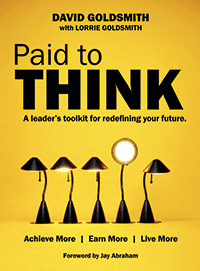Third of five parts
By David Goldsmith with Lorrie Goldsmith
If you feel you’re being expected to do more with less, you’re certainly not alone.
“Employers are looking for ways to accelerate their business strategy with fewer people,” says Jeffrey Joerres, chairman and CEO of employment giant Manpower.
While the concept of doing more with less is true, it’s not new. Nor should you perceive it as a negative challenge. Throughout history, leaders have always needed to do more with less, and they have developed innumerable measures to improve speed, accuracy, and quality, all while decreasing costs.
Devices and processes to do more with less
In 1792, Eli Whitney invented the cotton gin to do more with less. The invention increased productivity and improved quality at a lower cost and in less time than humans could. Two years later, horses were displaced by the first working steam locomotive that transported people and products faster and with greater storage capacities.
In the 1900s, Henry Ford implemented the Persian assembly line to transform production and quicken the rate at which products came to market. In the 1950s, mainframe computers in the back room were a revolutionary step toward work efficiencies of the present.
With the emergence of computers, efficiencies have moved from the back room, where human labor was needed for manual activities such as production, farming, and construction, to the front office. The front office similarly transformed as leaders responded to doing more with less. Functions that were once performed manually — think manual accounting ledgers — became manually automated in the 1980s with personal desktop computers.
Today, more functions are automated through local networks, intranets, and extranets. Imagine losing computers or email for a day; how many other functions and people would you need to perform the same tasks? An accounting department might need a hundred people to do the job that 20 can do with the help of computers.
The next logical progression in our quest to do more with less will be to increase the speed and accuracy with which decision-makers think. As far-fetched as it may sound, scientists already have technology in the works that is capable of merging human thought with automation to compensate for the unchanging rate of thinking.
How Zappos leveraged it’s ability to do more with less
For now, there are numerous ways in which leaders and managers can do more with less to move their organizations forward no matter where they fall on history’s timeline. Leveraging technology and building systems and structures are among the ways to successfully accomplish this.
For example, e-file tax returns, online banking, self check-out lines, and self-serve movie ticket kiosks were all born from the enterprising desire to do more with less — and they’ve not only helped businesses, they’ve made consumers’ lives more convenient.
In 2008, when e-commerce was down for the first time ever, online shoe retailer Zappos actually grew its gross merchandise sales to more than $1 billion because it successfully used technology to provide excellent customer service procedures such as ease of online ordering and returns, clear product displays, and rapid delivery times as well as to manage the databases of shoe suppliers, the coordination of shipping requirements, and the coordination of vendor warehouses. The online shoe company’s COO/CFP Alfred Lin attributed the firm’s ability to do more with less as the reason Zappos had cash flow in the black and even turned a profit.
Though the pressure appears to mount with the passage of time, rethink your beliefs that doing more with less is some new (and negative) challenge; it is a natural progression of potential opportunity, and it will always be.
As you’ve been asked to do more with less, so, too, will those working in the year 2038 or 2078. Embrace the concept, because if you know what to do with that opportunity by using the tools you already have and the ones you will be learning in this book, you can generate limitless rewards.
Excerpted with permission from Paid to THINK: A Leaders Toolkit for Redefining Your Future, by David Goldsmith with Lorrie Goldsmith. Copyright (c) 2012, BenBella Books.
Miss Parts 1 and 2? See Paid to Think: The Benefits of Winning by a Nose and Want to be Wildly Successful? Then Make Change a Welcome Friend.
